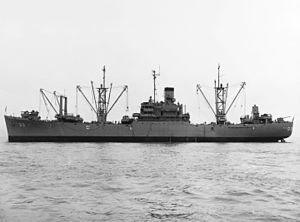
A warship or combatant ship is a naval ship that is built and primarily intended for naval warfare. Usually they belong to the armed forces of a state. As well as being armed, warships are designed to withstand damage and are typically faster and more maneuverable than merchant ships. Unlike a merchant ship, which carries cargo, a warship typically carries only weapons, ammunition and supplies for its crew. Warships usually belong to a navy, though they have also been operated by individuals, cooperatives and corporations.

High-speed transports were converted destroyers and destroyer escorts used in US Navy amphibious operations in World War II and afterward. They received the US Hull classification symbol APD; "AP" for transport and "D" for destroyer. In 1969, the remaining ships were reclassified as "Fast Amphibious Transports", hull symbol LPR.

Landing craft are small and medium seagoing watercraft, such as boats and barges, used to convey a landing force from the sea to the shore during an amphibious assault. The term excludes landing ships, which are larger. Production of landing craft peaked during World War II, with a significant number of different designs produced in large quantities by the United Kingdom and United States.
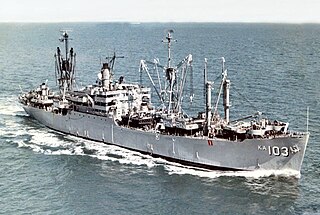
Amphibious cargo ships were U.S. Navy ships designed specifically to carry troops, heavy equipment and supplies in support of amphibious assaults, and to provide naval gunfire support during those assaults. A total of 108 of these ships were built between 1943 and 1945—which worked out to an average of one ship every eight days. Six additional AKAs, featuring new and improved designs, were built in later years. They were originally called Attack Cargo Ships and designated AKA. In 1969, they were renamed as Amphibious Cargo Ships and redesignated LKA.

Haskell-class attack transports (APA) were amphibious assault ships of the United States Navy created in 1944. They were designed to transport 1,500 troops and their combat equipment, and land them on hostile shores with the ships' integral landing craft.
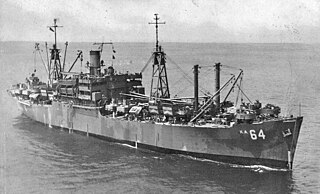
The Tolland-class attack cargo ships were built by North Carolina Shipbuilding Co. in Wilmington, North Carolina during the latter stages of World War II.

The Artemis-class attack cargo ships were a series of attack cargo ships (AKAs) built by Walsh-Kaiser Co., Inc. of Providence, Rhode Island during World War II.

The Arcturus-class attack cargo ships were converted from other ship types by Sun Shipbuilding & Drydock Co. in Chester, Pennsylvania, Tampa Shipbuilding Co. in Tampa, Florida, and Federal Shipbuilding & Drydock Co. in Kearny, New Jersey during World War II.

The 3"/50 caliber gun in United States naval gun terminology indicates the gun fired a projectile 3 inches (76 mm) in diameter, and the barrel was 50 calibers long. Different guns of this caliber were used by the U.S. Navy and U.S. Coast Guard from 1900 through to 1990 on a variety of combatant and transport ship classes.

The Gilliam-class attack transport was a class of attack transport built for service with the US Navy in World War II.
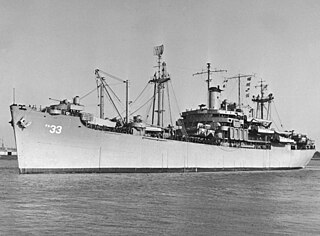
The Bayfield-class attack transport was a class of US Navy attack transports that were built during World War II.

The Windsor-class attack transport was a class of nine US Navy attack transports. Ships of the class saw service in World War II.

The Ormsby-class attack transport was a class of US Navy attack transport that saw service in World War II.
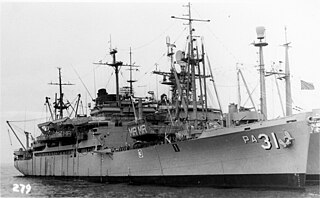
The Crescent City-class attack transport was a class of U.S. Navy attack transports that saw service in World War II and the Korean War. There were four ships in the class: USS Crescent City, USS Charles Carroll, USS Monrovia, and USS Calvert.

The Harris-class attack transport was a class of US Navy attack transport which saw service in World War II. The purpose of any attack transport was to deliver troops and their equipment to hostile shores in order to execute amphibious invasions using an array of smaller integral landing craft. Being intended to serve in forward combat areas, these ships were well armed with antiaircraft guns to protect itself and its vulnerable cargo of troops from air attack in the battle zone.

The Arthur Middleton-class attack transport was a class of three US Navy attack transport that saw most of its service in World War II. Ships of the class were named after signatories of the American Declaration of Independence.

The Doyen-class attack transport was a class of two attack transports that saw service with the US Navy in World War II. Ships of the class were named after generals of the United States Marine Corps.

An amphibious warfare ship is an amphibious vehicle warship employed to land and support ground forces, such as marines, on enemy territory during an amphibious assault.

The Ashland-class dock landing ship were the first class of dock landing ship of the United States Navy. They were built during World War II. A dock landing ship is a form of auxiliary warship designed to support amphibious operations. Eight ships were built for the United States Navy and they remained in US service until the 1960s. Two of the class were sold for export overseas, with one joining the Republic of China Navy and the other the Argentinian Navy. The two transferred ships stayed in service until the 1980s. All eight ships were scrapped.

The Juneau-class cruisers were United States Navy light cruisers that were modified version of the Atlanta-class cruiser design. The ships had the same dual-purpose main armament as USS Oakland with a much heavier secondary antiaircraft battery, while the anti-submarine depth charge tracks and torpedo tubes were removed along with a redesigned superstructure to reduce weight and increase stability. Three ships were ordered and built, all completed shortly after World War II, but only Juneau remained active long enough to see action during the Korean War.
